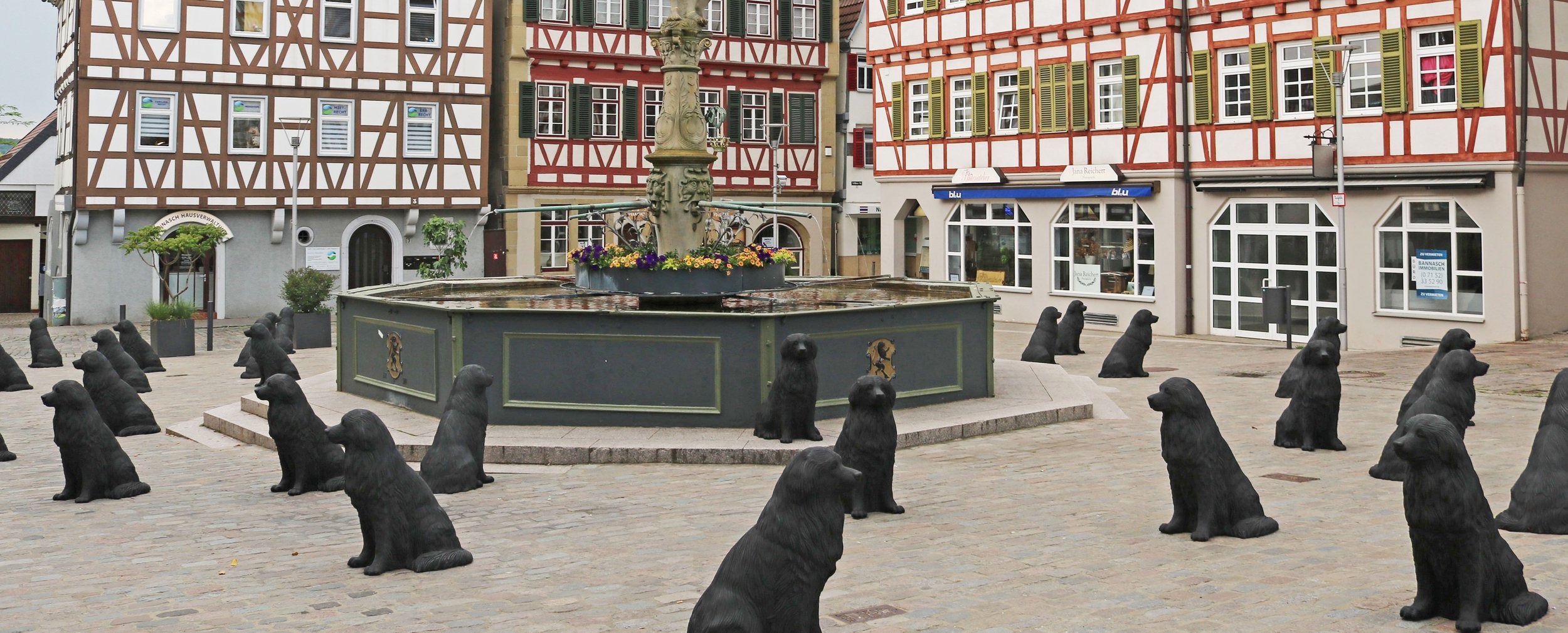
Background
The background of the Leonberger is a very clouded one, full of mysteries and turbulent tales. Many things have been written, sometimes accounts contradicted others, and little proof has been given for many of the stories. It was not until the early part of the 20th century that litters were registered and records were kept. The breed was officialy recognized by FCI in 1955.
A brief history
To start at the beginning, we go back to the early years of the 19th century. In Leonberg, a small rural town 20 km northwest of Stuttgart in Wurttemberg (Germany) Heinrich Essig was born in 1809. He turned out to be a very ambitious man, and he became a very prominent citizen, elected to the town council and possessing a strong talent for marketing and trading.
His greatest passion was for all kinds of animals and his house (Schweizerhaus) was more like a private little zoo, with all kinds of dogs, foxes, turkeys, peacocks and so on. There are also a number of claims that Essig was a trader in exotic animals.
This account was written of Essig's creation of the Leonberger : "Amongst his dogs there was a black and white Newfoundland female (Landseer type). He crossed her with a longhaired Barry-dog (St. Bernard) he owned also. He crossed them for 4 generations, out crossed again with a Pyrenean Wolfhound (Pyrenean Mountain Dog) crossed again with a St. Bernard". There is, however, no proof that this is in fact what was done and that there were no other dogs involved.
Essig started breeding in 1846, which is the date we now attribute to be the birth of the Leonberger.
In an article in the "Illustrierte Zeitung", dated November 1865, there is mention that Essig had 17 years of breeding experience. In another paper (Illustrierte Handwerkers Zeitung Nummer 10 Jahrgang 1870) Th. Hering writes a story of a dog breeder in Leonberg (Essig) where Essig claimed that he had been breeding dogs for about 20-24 years. In the same article, the dogs mentioned are Leonberger or Gotthard dog and a picture was published to show to readers what they looked like.
Large impressive dogs were very much in demand and there were years that Essig exported more than 300 dogs. The St. Bernard was very much in favor, but had become very rare. In fact, after a catastrophe in 1855, there was only one couple left at the St. Bernard pass. These dogs were crossed with Newfoundland females from Stuttgart, other local dogs, and English breeders crossed them with Mastiffs to obtain a more powerful head.
Essig died in 1889 without ever defining a standard for the breed or a defensible description of his breeding program. It is a tribute to the qualities of the Leonberger that in spite of harsh criticism from the dog fancy establishment, there were enough enthusiastic owners to form, beginning in 1891, the first Leonberger club. Unfortunately, this first Leonberger club did not survive very long and it was not until 1895 that the “Internationaler Klub für Leonbergerhunde” was founded with Albert Kull as president. Kull was also the author of the first Leonberger Standard. With the eye of an artist he did a good enough job that this standard formed the foundation for all subsequent standards.crossed them with Mastiffs to obtain a more powerful head.
World War 1
The war almost rendered the breed extinct. If it were not for the determination and dedication of two men, Karl Stadelmann and Otto Josenhans, the breed would surely have become a mere footnote in the history of German dogs. After the War, they scoured Germany searching for Leonbergers. They found 25. Of these, only five were suitable for breeding. Because of inflation and food shortages, it was unlikely that individuals could have personally and individually supported breeding programs, so in 1922 a group of seven people joined together to form a breeding cooperative. Within four years, they had selectively bred 350 Leonbergers. The organized breeding program of the cooperative brought about a revival of the breed, brought honor to the town, and provided foundation stock to establish several kennels. Most notably, these men established the official Breed Registry, which continues uninterrupted today. It is interesting to note that during this time, a pair from the cooperative produced two litters in New Jersey. These dogs were sold throughout America, but all signs of them disappeared during the depression.
World War 2
In the early 1930s, the authoritarian control of the Third Reich began to influence the dog world, assuming control of all German breed registries. A Reich-governed Leonberger club was established. However, “unofficial? breeding, although very reduced, continued throughout the war in and around Leonberg. Both dogs and accurate records survived the destruction and the current German Leonberger Club was formed in 1948. Under the guidance of club president Robert Beutelspacher, the first modern-day standard and breeding regulations were written. In 1975, the German Club brought all the Leonberger breed clubs from the major European nations together and founded the International Union of Leonberger Clubs. Eighteen national clubs including the Leonberger Club of America (since 1987) meet annually in Leonberg to preserve and protect the breed.








